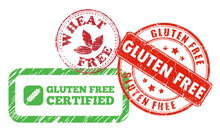
All You Need to Know About the New Gluten-Free Labeling Rule
 We see the words “gluten-free” on labels all the time. But until very recently, there wasn’t a universal agreement about what that legally meant in the US. While the upcoming rule isn’t perfect, it finally offers some protection for the gluten-free community. Let’s talk about what’s covered, what’s not and what you need to know.
We see the words “gluten-free” on labels all the time. But until very recently, there wasn’t a universal agreement about what that legally meant in the US. While the upcoming rule isn’t perfect, it finally offers some protection for the gluten-free community. Let’s talk about what’s covered, what’s not and what you need to know.
The Basics
In August of 2013, the FDA put out a ruling that defines the term “gluten-free” for products sold in the US. As soon as the rule goes into effect on August 5, 2014, products marked “gluten-free” legally must contain less than 20 parts per million (ppm) of gluten. This includes both the gluten that a manufacturer intentionally added and also any gluten that accidentally gets into the product during processing or handling, which is also known as cross contamination.
What’s covered?
The rule covers all foods under the FDA. The FDA regulations apply to most packaged foods and all nutritional supplements. It only affects products that choose to use the terms “gluten-free,” “free of gluten,” “no gluten,” or “without gluten.” It will not affect any packaged food without a gluten-free claim, so most items on the shelf will still only contain the food allergy labeling information and any other voluntary disclosures that manufacturers decide to provide.
Meat, poultry, fish and egg products aren’t covered under this rule. Prescription medications, over-thecounter drugs, cosmetics or any other personal care items are also not covered.
When?
The new rule goes into effect August 5, 2014, but manufacturers are encouraged to get on board and meet the requirements ASAP.
Frequently Asked Questions
What about oats?
Oats are allowed in products marked gluten-free as long as the final product contains less than 20 ppm of gluten.
Will the “made in a shared facility” statements on packages still be used?
Yes, those statements are unlikely to disappear any time soon. The voluntary allergen statements, such as “made in a shared facility,” “made in a shared factory,” or “made on shared lines” do cause a lot of confusion for consumers, but the new ruling doesn’t address those statements. Some products marked gluten-free will still contain those statements, but then consumers can have confidence that less than 20 ppm of gluten is in the final product.
Wait … shouldn’t gluten-FREE mean ZERO gluten?
At this point, in 2014, it’s not possible to measure accurately down to zero ppm. Researchers around the world agree that 20 ppm is safe for almost all people with celiac disease. Canada, Europe, Israel and other countries also define glutenfree as less than 20 ppm. Just to give some perspective, 20 ppm is a ridiculously small amount. If you took a piece of regular bread and cut it into 7,030 pieces, one of those little pieces is around 20ppm, which is considered the maximum amount that someone with celiac disease can safely eat. It’s smaller than most crumbs. (We don’t know yet how much gluten is safe for someone with gluten sensitivity.)
There are some members of the celiac community who report experiencing symptoms below 20 ppm. Many people, myself included, wanted to see glutenfree defined as a smaller amount, but that didn’t happen. There were many logistical, political, economic and other factors that went into the FDA’s decision. However, according to expert consensus, the new ruling will be a safe level for almost everyone with celiac disease.
Do any stricter standards exist?
There are a variety of gluten-free organizations which already certify products as gluten-free, and the new ruling won’t change those in any way. The current certifications are:
• CSA Recognition Seal through the Celiac Sprue Association (CSA) – food must test under 5 ppm
• Gluten-Free Certification Organization (GFCO) through the Gluten Intolerance Group – food must test under 10 ppm
• Gluten-Free Certification Program (GFCP) through the Canadian Celiac Organization and the National Foundation for Celiac Awareness – food must test under 10 ppm
• QAI Gluten Free Certification through Quality Assurance International (QAI) – food must test under 10 ppm
CSA products are certified to contain less than 5 ppm of gluten. GFCO, GFCP, and QAI products contain less than 10 ppm of gluten.
How will this rule help me?
The FDA estimates that 5% of products on the shelf right now that are labeled gluten-free really contain more than 20 ppm of gluten. Yikes! While it’s reassuring that 95% of foods marked gluten-free are below the 20 ppm threshold, it’s disturbing to think that some products on the shelf now marked gluten-free do contain enough gluten to cause health problems.
The good news is that this rule will provide a potential framework for enforcement and require corrective action if and when products labeled gluten-free are demonstrated to contain 20 ppm of gluten or more. Currently, any recalls are voluntary and quite rare.
Who is responsible for enforcing this rule?
As of August 2014, the rule will be under the FDA. Complaints can be made by calling the Center for Food Safety and Applied Nutrition’s Adverse Event Reporting System called “CAERS” at 240-402-2405. For additional resources around the US, visit: http://www.fda.gov/safety/reportaproblem/ consumercomplaintcoordinators/
Surprises & Quirks in the Rule
No specific testing requirements
With gluten-free defined as less than 20 ppm, it would logically follow that manufacturers must test products to make sure they’re below that level. However, the rule doesn’t mandate testing. The FDA states, “Manufacturers are responsiblefor ensuring that foods bearing a gluten-free claim meet the requirements of the final rule.” They offer some suggestions and options for testing and encourage “effective quality control,” but there are no concrete requirements. The FDA does not have plans for specific factory inspections, nor do they require manufacturers to keep records on gluten content of batches.
On one hand, it’s not really necessary for a company to, say, do daily tests on batches of bagged oranges to verify that they’re gluten-free. However, the global lack of a testing standard is still disappointing.
“Gluten-removed” grains
The ruling does allow gluten-free products to contain certain ingredients that have been processed to remove gluten. Some examples of these are wheat starch, hydrolyzed wheat starch, or glucose syrup. These are specially processed and then tested to ensure that they are below 20 ppm of gluten. While glutenremoved wheat products have been available in Europe for years and experts have concluded that these products are safe, they are rarely seen in North American markets. Several manufacturers intro-duced them here a few years back and enough gluten-free customers complained.
Note: Wheat starch, glucose from wheat and the like are ONLY considered gluten-free if they specifically say that they are processed to remove gluten.
Gluten-free beer
While gluten-removed grains tested to less than 20 ppm are allowed under the new ruling, gluten-removed beer is a little more complicated. Fermented foods made with gluten – like beer, soy sauce and sourdough bread –
potentially have lower levels of gluten. Unfortunately, the fermentation process also makes it much harder to accurately measure the gluten content of the final product. Beer made from barley actually falls under the Alcohol and Tobacco Tax and Trade Bureau (TTB), not the FDA, but the TTB has been clear that all gluten-removed beers must contain a warning stating that it’s impossible to verify the gluten level in the final product. I know, I know. People take their beer very seriously, but your health is worth more than a beer.
This is an area of a lot of research and debate, so it’s likely that more information will be available in the next few months and years. Until then, if you need a beer, stick to beers made from gluten-free grains, like sorghum beers.
Restaurants
One nice surprise is that the ruling states that restaurants are expected to get on board and meet the gluten-free standard for anything labeled gluten-free. However, the FDA still hasn’t announced a plan for how this is going to happen.
It will be about a decade between the time that the FDA was first asked to define gluten-free to the time that the ruling will go into effect. Many gluten-free organizations and passionate individuals spent a great deal of time, energy and effort to make this happen (including a media campaign with a giant gluten-free cake!). Although the ruling isn’t exactly what everyone wanted and there are still some areas of concern, it’s a real start that will hopefully lead to safer food choices for those following a strict gluten-free diet.
Written by Cheryl Harris
Gluten Free & More magazine, published by Edgewater Park Media Inc. (EPM) is publishing this article for purposes of medical topic, however no warranty whatsoever is made that the article is accurate and there is absolutely no assurance that any statement contained or cited in the article touching on medical matters is true, correct, precise or up to date. EPM further emphasizes that nobody in the company takes responsibility for the results or consequences of any attempt to use or adopt any information presented in the article. Always seek the advice of a medical professional before starting any new protocol.




Pingback: Gluten Free Allergy Free Lunch Recipes for Kids | Simply Gluten Free
Pingback: Gluten Free Nutty Tarts | Gluten Free Recipes | Gluten Free Diet
Pingback: Gluten Free Lemon Poppy Seed Quick Bread Recipe | Gluten Free Diet
Pingback: Gluten Free Polynesian Kebabs | Gluten Free Recipes | Gluten Free Diet